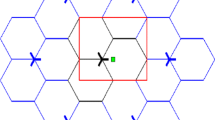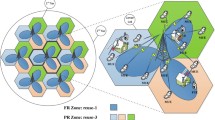Abstract
Femtocell technology is an emerging solution that is promising for improving indoor coverage problems and enhancing cell capacity. In a femtocell network, the overall system performance depends on the access method utilized, which specifies whether a specific user equipment can connect to the femtocell network. Three access methods are defined for long-term evolution (LTE) femtocell networks: open access, closed access and hybrid access. For fair and effective use of resources, hybrid access is preferred. Because some of the resources are shared among nonregistered users, it is essential to regulate their scheduling schemes. This study investigates resource scheduling for femtocell networks in hybrid access mode, which gives preferential access to the high-priority traffic of nonsubscribers. High-priority traffic metric (THP) is calculated for high-priority users, and low-priority traffic metric (TLP) is calculated for low-priority users. Then, individual sorted lists are formed for (THP) and (TLP). Nonsubscribers from the (THP) list are allocated initially, after which UEs from the (TLP) list are chosen for allocation based on resource availability, thereby increasing the overall average throughput of high-priority users in a network.
Similar content being viewed by others
References
V. Chandrasekhar, J. F. Andrews, A. G atherer. Femtocell networks: a survey [J]. IEEE Communications Magazine, 2008, 46(9): 59–67
H. Claussen, L. T. W. Ho, L. G. Samuel. An overview of the femtocell concept [J]. Bell Labs Technical Journal, 2008, 13(1): 221–245
A. Barbieri, A. Damnjanovic, T. Ji, et al. LTE femtocells: system design and performance analysis [J]. IEEE Journal on Selected Areas in Communications, 2012, 30(3): 586–594
A. Damnjanovic, J. Montojo, Y. Wei, et al. A survey on 3GPP heterogeneous networks [J]. IEEE Wireless Communications, 2011, 18(3): 10–21
D. Calin, H. Claussen, H. Uzunalioglu, et al. On femto deployment architectures and macrocell offloading benefits in joint macro-femto deployments [J]. IEEE Communications Magazine, 2010, 48(1): 26–32
P. Lin, J. Zhang, Y Chen, et al. Macro-femto heterogeneous network deployment and management: from business models to technical solutions [J]. IEEE Wireless Communications, 2011, 18(3): 64–70
H. S. Jo, P. Xia, J. G. Andrews. Open, closed and shared access femtocells in the downlink [J]. EURASIP Journal on Wireless Communications and Networking, 2012, 2012(363): 1–16
P. Mach, and Z. Becvar. QoS guaranteed power control mechanism based on the frame utilization for femtocells [J]. EURASIP Journal on Wireless Communications and Networking, 2011, 2011(16): 1–16
L. Fu, S. C. Liew, J. Huang. Fast algorithms for joint power control and scheduling in wireless networks [J]. IEEE Transactions on Wireless Communications, 2010, 9(3): 1186–1197
M. Iturralde, T. A. Yahiya, A. Wei, et al. Interference mitigation by dynamic self power control in femtocell scenarios in LTE network [C]//IEEE Global Communications Conference, Anaheim, 2012: 1–6
H. S. Jo, J. G. Yook, C. Mu, et al. A self organized uplink power control for cross tier interference management in femtocell networks [C]//IEEE Military Communications Conference, San Diego, 2008: 1–6
S. J. Kao, H. L. Wang. Dynamic orthogonal frequency division multiple access resource management for downlink interference avoidance in two tier networks [J]. International Journal of Communication Systems, 2015, 28(2): 281–295
I. Guvenc, M. R. Jeong, F. Watanabe, et al. A hybrid frequency assignment for femtocells and coverage area analysis for co-channel operation [J]. IEEE Communications Letters, 2008, 12(12): 880–882
V. Chandrasekhar, J. G. Andrews. Spectrum allocation in two tier networks [J]. IEEE Transactions on Communications, 2009, 57(10): 3059–3068
X. Tao, Z. Zhao, R. Li, et al. Downlink interference minimization in cooperative cognitive LTE femtocell networks [J]. EURASIP Journal onWireless Communications and Networking, 2013, 2013(194): 1–12
J. Xiang, Y. Zhang, T. Skeie, et al. Downlink spectrum sharing for cognitive radio femtocell networks [J]. IEEE Systems Journal, 2010, 4(4): 524–534
Y. J. Zhang, S. W. Wang. Resource allocation for femtocell networks by using chance constrained optimization [C]//IEEE Wireless Communications and Networking Conference, New Orleans, 2015: 1805–1810
P. Xia, V. Chandrasekhar, J. G. Andrews, et al. Femtocell access control in the TDMA/OFDMA uplink [C]//IEEE Global Telecommunications Conference, Miami, 2010: 1–5
H. S. Jo, P. Xia, J. G. Andrews, et al. Downlink femtocell networks: open or closed [C]//IEEE International Conference on Communications, Kyoto, 2011: 1–5
L. Li, C. Xu, M. Tao. Resource allocation in open access OFDMA femtocell networks [J]. IEEE Wireless Communication Letters, 2012, 1(6): 625–628
H. Marshoud, H. Otrok, H. Barada, et al. Macrocell femtocells resource allocation with hybrid access motivational model [J]. Physical Communication, 2014, 11: 3–14
G. de la Roche, A. Valcarce, J. Zhang. Access control mechanisms for femtocells [J]. IEEE Communications Magazine, 2010, 48(1): 33–39
3GPP. Tech. Specific. Group Radio Access Network—Physical Channel and Modulation (Release 8) [S]. 3GPP TS36.211
J. Fan, Q. Yin, G. Y. Li, et al. MCS selection for throughput improvement in DLLTE system [C]//IEEE Conference on Computer Communications and Networks, Hawaii, 2011: 1–5
S. F. Sulthana, R. Nakkeeran. Performance analysis of service based scheduler in LTE OFDMA system [J]. Wireless Personal Communications, 2015, 83(2): 841–854
G. Piro, L. A. Grieco, G. Boggia, et al. Simulating LTE cellular systems: an open source framework [J]. IEEE Transactions on Vehicular Technology, 2010, 60(2): 498–513
Author information
Authors and Affiliations
Corresponding author
Additional information
The associate editor coordinating the review of this paper and approving it for publication was G. D. Yu.
S. Fouziya Sulthana received her B.E. degree in electronics and communication from Bharadidasan University, Tamilnadu in 2002, M.Tech and Ph.D. degrees in electronics and communication from Pondicherry University, Puducherry in 2008 and 2017, respectively. She worked as an Assistant Professor in private engineering college. Her current research interests include radio resource management in broadband networks.
R. Nakkeeran received his B.Sc. degree in science and B.E. degree in electronics and communication engineering from Madras University in 1987 and 1991 respectively and M. E. degree in electronics and communication engineering (with diversification in optical communication) from Anna University in 1995. He received his Ph.D. degree from Pondicherry University in 2004. Since 1991, he has been working in the teaching profession. Presently, he is an Associate Professor in the Department of Electronics Engineering, School of Engineering and Technology, Pondicherry Central University. He is a life member of IETE, ISTE, OSI and fellow of IE(I). Also, he is a member of IEEE, OSA, IEICE and SPIE. He has published around 175 papers in National and International Conference Proceedings and Journals. He has co-authored a book, published by PHI. His research interests include optical communication, networks, antennas, electromagnetic fields and wireless communication.
Rights and permissions
About this article
Cite this article
Sulthana, S.F., Nakkeeran, R. Priority-Based Resource Scheduling in Hybrid-Access LTE Femtocell. J. Commun. Inf. Netw. 3, 75–83 (2018). https://doi.org/10.1007/s41650-018-0010-9
Received:
Accepted:
Published:
Issue Date:
DOI: https://doi.org/10.1007/s41650-018-0010-9




